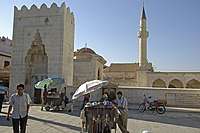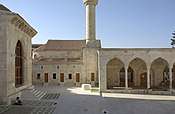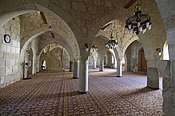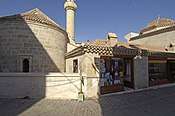Yağ Cami
Yağ Cami (English: Oil Mosque) is a historical mosque located in the old town of Adana, Turkey.[1]. The mosque is originally built as the St. Jacob Church in around 1250 AD and converted into a mosque in c.1380 by the Ramazanoğlu Bey Şihabeddin Ahmed[2], just after taking over the city from the Armenian Kingdom of Cilicia. It is the oldest mosque in the city and later on formed part of the külliye that also includes a madrasah.
| Yağ Cami | |
|---|---|
 Yağ Cami | |
| Religion | |
| Affiliation | Islam |
| District | Seyhan Müftülüğü |
| Rite | Sunni |
| Year consecrated | late 14th century |
| Status | Active |
| Location | |
| Location | |
| Geographic coordinates | 36°59′01″N 35°19′37″E |
| Architecture | |
| Type | Eastern Orthodox Church |
| Completed | 1250 (as St.Jacob church) |
History

Saint Jacob Church was built in around 1250 as an Eastern Orthodox Church, by the Byzantine Empress for the Byzantine Christians who are on their pilgrimage to Holy Land. Evliya Çelebi states the reason for building the church outside the city walls, was the hostility of city's Armenians towards Byzantines.[3].Adana was ceded to the Mamluk Sultanate in 1359 and in the next decades, many Turkish families moved to the city. To practice their religious duties, the church was converted into a mosque in around 1380 by the Ramazanoğlu Bey Şihabeddin Ahmed and was known as Eski mosque (English: Old mosque), after the built of Ulu Camii. The mosque was renovated in 1501 by Gıyâseddîn Halil Bey.[4] Later, his son Piri Mehmet Paşa built its minaret in 1525 and its madrasah in 1558.[5] From mid 19th century, the mosque became known with the current name, getting the name from the oil bazaar opened just next to it.[6]
Architecture


Mosque
The praying area has a rectangular shape and it is split into five naves with four rows of columns. The mihrab of the mosques is the apsis that remained from former church. The gate of the mosques is of yellow and black colored stone and is an important work of art.[7]

Madrasah
The medrese is located in the courtyard of the mosque. There are classrooms, cells (bedrooms) and a kitchen in the madrasah. Classrooms are covered with domes and cells have cradle arches. Arcades in front of the cells are great samples of wooden artwork.
References
- Ministry of Culture and Tourism of Turkey
- Nurettin Çelmeoğlu. "Yazıttaki 'Cedde' sözcüğü Yağ Camideki gizli saklıyor". Bölge Gazetesi. Retrieved 20 February 2020.
- Nurettin Çelmeoğlu. "Öncesi kiliseymiş, 'Yağ Camii' olmuş". Bölge Gazetesi. Retrieved 20 February 2020.
- "History of Adana".
- "Eski Camii(Yağ Camisi) (Turkish)". Kenthaber Kültür Kurulu. Retrieved 4 February 2008.
- "Adana Tarihi Yerler (Turkish)". Adana Governship Department of Tourism and Culture.
- "A look into Adana's history by Incirlik Air Base". Archived from the original on 2011-07-22.
| Wikimedia Commons has media related to Yağ Mosque, Adana. |

